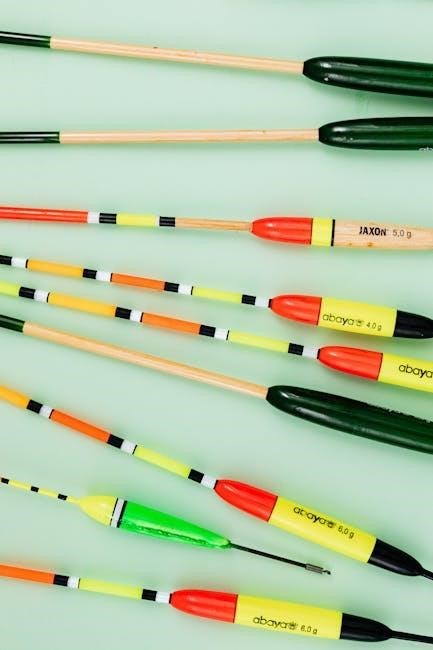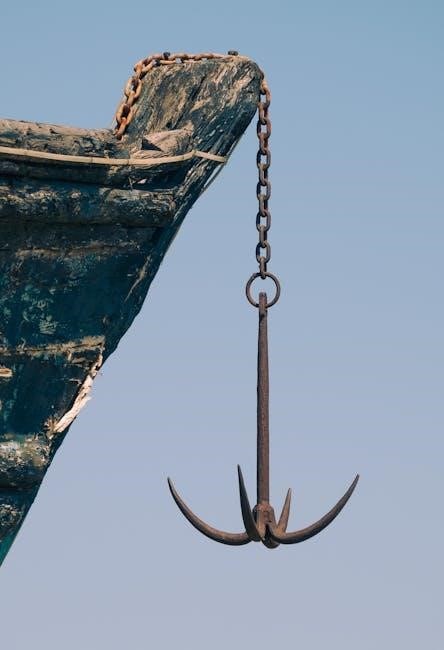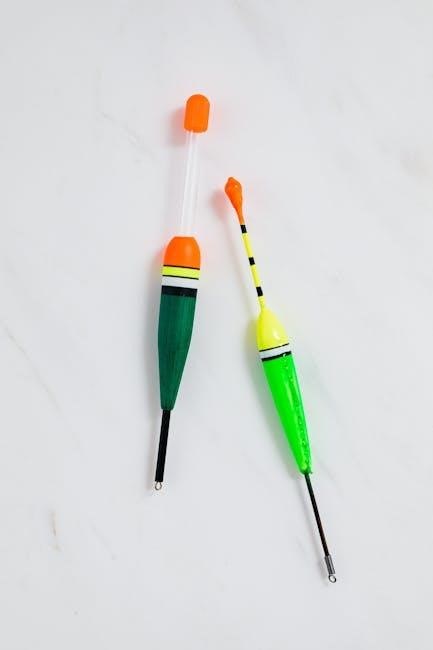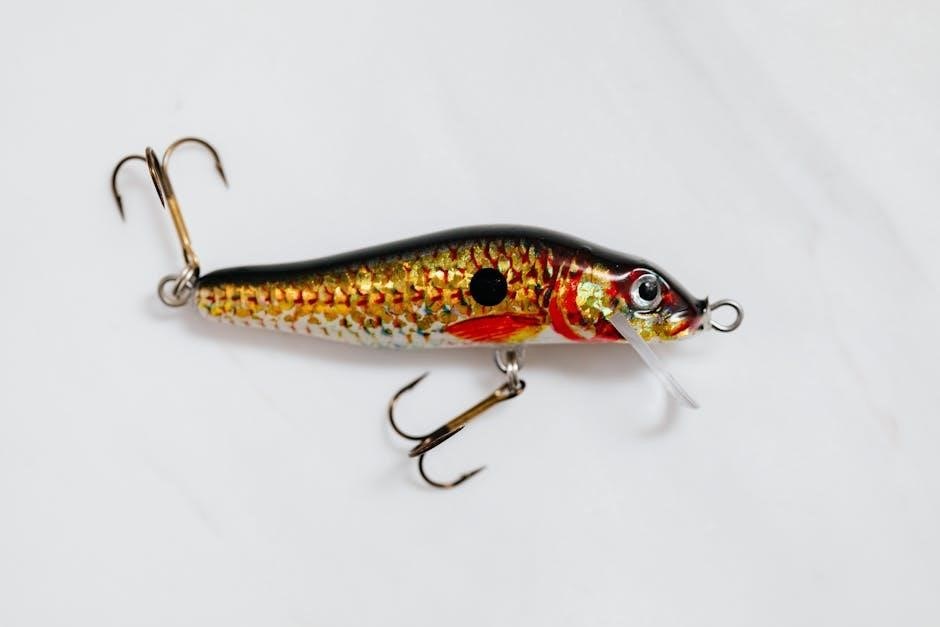instruction for putting away fishing tackle
Proper fishing tackle storage is crucial for maintaining gear in top condition, preventing damage, and ensuring longevity. Organized storage protects against environmental factors, preserves performance, and maximizes your investment in fishing equipment, leading to more successful outings.
Cleaning and Inspection
Before storing, thoroughly clean your tackle to remove dirt, salt, and grime. Inspect each item for damage, corrosion, and wear. Replace any rusty hooks to maintain the effectiveness of your fishing gear.
Washing Tackle After Use
After each fishing trip, it’s essential to wash your tackle with fresh water. This removes salt, dirt, and other debris that can cause corrosion. Use a mild soap for stubborn grime. Rinse thoroughly and allow all tackle to air dry completely before storing. This simple step extends the life of your gear and keeps it performing optimally, preventing rust and damage. Ensure every item is dry to prevent mold growth.
Inspecting for Damage and Corrosion
Regularly inspect your fishing tackle for signs of damage and corrosion. Check hooks for rust, bends, or breaks. Examine lures for chipped paint or cracks. Look at metal parts for any corrosion, especially after saltwater use. Address any issues promptly by cleaning, repairing, or replacing damaged components. This proactive approach prevents minor problems from escalating, ensuring your tackle remains reliable and ready for your next fishing adventure, saving you money in the long run.
Replacing Hooks on Lures
After each fishing trip, meticulously inspect the hooks on your lures. If you notice any rust, dullness, bending, or breakage, promptly replace the affected hooks. Replacing worn hooks ensures better hooksets and prevents lost fish. Use high-quality replacement hooks that match the size and strength of the originals. Properly dispose of the old hooks to avoid accidental injuries. Regularly replacing hooks is a simple yet effective way to maintain the effectiveness of your lures and increase your chances of a successful catch.

Line Care
Proper line care is essential for maintaining its strength and integrity. Protect your fishing line from sunlight and store monofilament in water to prevent it from drying out, ensuring its longevity and performance.
Protecting Line from Sunlight
Sunlight degrades fishing line, reducing its strength and increasing the likelihood of breakage. To protect your line, store it in a dark, cool place. Avoid leaving spools exposed to direct sunlight, especially on balconies or in garages with fluctuating temperatures. Consider using line conditioner products that offer UV protection. Keeping your line shielded from the sun extends its lifespan and ensures reliability when you need it most. It’s key for successful fishing.
Storing Line in Water (Monofilament)
Some anglers believe storing monofilament line in water can help maintain its suppleness and strength. Submerging the line in a container with a small amount of water, and then storing it in the refrigerator, can prevent it from drying out and becoming brittle. Ensure the water is clean and free of contaminants. This method is particularly useful during winter. Remember to check the line’s condition before your next fishing trip. It may extend its lifespan.

Rod and Reel Storage
Proper rod and reel storage is vital for protecting your equipment. This prevents damage and ensures they’re ready for your next fishing adventure. Safe storage maintains performance and extends the lifespan of your gear.
Rod Storage Options (Racks, Cases, Tubes)
Rod storage options are varied, offering solutions for every angler’s needs. Racks keep rods organized and accessible, preventing them from leaning against walls or other gear. Cases provide robust protection during transport and storage, safeguarding against impacts and scratches. Tubes offer a lightweight and compact solution, ideal for protecting individual rods, especially during travel. Choosing the right option depends on space, budget, and how frequently you transport your equipment.
Reel Maintenance and Storage
Reel maintenance is essential for smooth operation and longevity. After each use, rinse your reels with fresh water to remove salt and debris. Periodically lubricate moving parts with reel-specific oil or grease. When storing reels, loosen the drag to prevent pressure on the internal components. Store reels in a dry, cool place, ideally in a reel bag or case, to protect them from dust, sunlight, and physical damage, ensuring they perform flawlessly on your next fishing trip.

Tackle Box Organization
Organizing your tackle box ensures efficient access to your gear and protects it from damage. A well-organized tackle box saves time on the water and enhances your fishing experience.
Using Tackle Boxes, Bags, and Organizers
Tackle boxes, bags, and organizers are essential for storing and transporting fishing gear. Choose the right size and type based on your needs, considering factors like capacity and portability. Tackle boxes offer structured compartments, while bags provide flexibility and space. Organizers help keep small items like hooks and swivels neatly arranged, preventing tangling and damage. Utilize these tools to maintain a clutter-free and efficient fishing setup.
Sorting and Separating Tackle
Sorting and separating tackle is key to efficient organization and quick access on the water. Group similar items together, such as lures, hooks, and weights, in dedicated compartments or containers. Separate different types of lures by size, color, or style. This prevents tangling, protects finishes, and makes it easy to find what you need when you need it. Labeling compartments can further enhance organization and save time when selecting the right tackle.
Environmental Considerations for Storage
Environmental control is vital for preserving fishing tackle. Temperature fluctuations, humidity, and sunlight can damage gear. Proper storage mitigates these risks, extending tackle life and maintaining performance for future fishing trips.
Temperature and Humidity Control
Maintaining stable temperature and humidity levels is crucial for preventing tackle degradation. Ideally, store gear in a cool, dry place, avoiding extreme heat or cold. High humidity can cause corrosion on metal components, while fluctuating temperatures can damage lines and lures. Consider using dehumidifiers or desiccants in storage areas to regulate moisture. Aim for a consistent environment to prolong the life of your valuable fishing equipment.
Protecting from Direct Sunlight
Direct sunlight is detrimental to fishing tackle, causing fading, weakening, and warping of various materials. Ultraviolet (UV) rays degrade fishing lines, making them brittle and prone to breakage. Lures and plastic baits can become discolored and lose their effectiveness. Store tackle in shaded areas or use opaque containers to shield it from the sun’s harmful rays. This simple precaution significantly extends the lifespan of your gear, ensuring optimal performance on every fishing trip.
Pest Control
Pests, such as rodents and insects, can wreak havoc on fishing tackle. Rodents may chew on rod handles, lines, and tackle boxes, while insects can damage soft baits and fabrics. Implement pest control measures in your storage area. Use sealed containers to protect tackle. Consider using natural repellents like cedar or bay leaves. Regularly inspect your storage area for signs of pests and address any infestations promptly to prevent extensive damage to your valuable fishing gear.
Storage Location
Selecting the right storage location is vital; Avoid areas with extreme temperature fluctuations and direct sunlight. A cool, dry, and stable environment will help prolong the life of your fishing tackle.
Suitable Storage Locations (Avoiding Balconies and Garages)
Ideal storage locations avoid the temperature extremes found on balconies and in garages. Balconies expose tackle to direct sunlight and fluctuating humidity, while garages often experience drastic temperature shifts. Instead, consider indoor spaces like closets, spare rooms, or basements that offer a more controlled environment, protecting your gear from degradation and maintaining its optimal condition for your next fishing trip. Ensuring a stable environment is key.
Ideal Temperature Range
The ideal temperature range for storing fishing tackle is between 5°C and 8°C (41°F and 46°F). This range helps prevent damage from extreme heat or cold, preserving the integrity of lines, rods, and lures. Avoiding significant temperature fluctuations is also crucial, as these can lead to condensation and corrosion. Maintaining a stable, cool environment will extend the lifespan of your valuable fishing gear and ensure it performs optimally.
Specific Tackle Storage Tips
Different types of tackle require specific storage methods. Addressing these needs helps prevent damage, tangling, and corrosion. Proper storage ensures your gear is ready for your next fishing adventure, maximizing its lifespan.
Wobblers
Wobblers, known for their enticing swimming action, require careful storage. After use, rinse them thoroughly to remove any residue or debris. Store them in tackle boxes with individual compartments to prevent hooks from tangling and scratching the lure’s finish. For long-term storage, ensure they are completely dry to prevent corrosion. Consider storing wobblers in a cool, dark place to protect their colors and finishes from fading, maintaining their effectiveness for future fishing trips. This attention to detail will significantly extend their lifespan.
Silicone Baits
Silicone baits demand particular storage to preserve their texture and effectiveness. Keep them separate from other types of lures, as some materials can react and cause melting or discoloration. Store silicone baits in resealable bags or containers, ideally with a small amount of silicone-friendly lubricant to prevent drying out. Protect them from direct sunlight and extreme temperatures, which can degrade the material. A cool, dark location is best. Proper storage ensures these baits remain supple and attractive to fish for repeated use during your fishing adventures.

Transporting Tackle
Transporting fishing tackle requires careful planning to prevent damage and maintain organization. Utilize protective cases and bags designed for fishing gear to ensure safe and efficient transport to your fishing location.
Using Cases and Tubes for Protection
Cases and tubes provide robust protection for rods and reels during transport. Hard-sided cases shield against impacts, while tubes prevent bending and breakage. Select cases with internal padding and secure closures to minimize movement and vibration. Ensure rods and reels fit snugly within the case to avoid damage from external pressure, safeguarding your valuable equipment while traveling to your favorite fishing spot. This ultimately extends their lifespan and performance.
Choosing the Right Carrying Bag
Selecting the right carrying bag involves considering size, compartments, and material. Look for bags with dedicated sections for rods, reels, and tackle boxes. Water-resistant materials protect against moisture, while padded straps ensure comfortable carrying. Consider the weight capacity and durability of the bag to handle your gear. A well-designed carrying bag simplifies transportation, keeps your tackle organized, and minimizes the risk of damage during your fishing adventures, ensuring everything is readily accessible when you need it.
Winter Storage
Winter storage requires extra care. Clean and dry all tackle, lubricate reels, and store line properly. Protect rods and reels from extreme temperatures and humidity to prevent damage during off-season storage.
Preparing Tackle for Long-Term Storage
Before storing your fishing tackle for an extended period, like winter, thorough preparation is essential. Start by cleaning each item to remove dirt, grime, and saltwater residue. Inspect all components for wear, corrosion, or damage, addressing any issues before storage. Replace any rusted hooks or split rings. Properly lubricating moving parts, such as reels, ensures they remain in good working condition.
Special Considerations for Winter Conditions
Winter storage demands specific attention to temperature and humidity; Extremely cold temperatures can damage certain materials, while high humidity promotes corrosion. Store tackle in a location where the temperature remains above freezing and is relatively stable. Consider using moisture-absorbing products to minimize humidity. Protect fishing lines from extreme cold, as it can cause them to become brittle and easily break.
